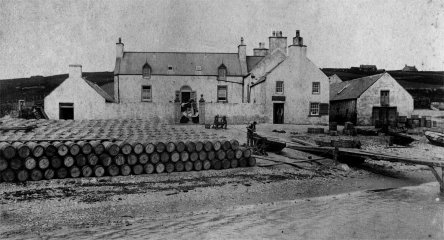
Fishing for herring was of little interest until the technique of curing them with salt in barrels was mastered.
From the 15th to the 17th centuries fishing for herring around Shetland was dominated by the Dutch. They used drift nets to catch the fish before they were cured onboard the large decked boats or 'busses' that carried everything needed on a trip.
Herring stations were located at Hamar's Voe, Hillswick, Hamnavoe and Heylor. At the herring stations it was usually girls and women who were employed as gutters. When the boats landed their catch, the herring was put into troughs called farlins. The women were so adept at their profession that a single cut with a gutting knife removed the entrails, the herring then being passed on to the packers, who lightly salted and layered the fish in barrels. After a day or two the herring were repacked, this was done at least once more, before being sealed for export.

